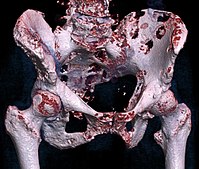
Photo from wikipedia
Simple Summary The association between the tumor immune microenvironment (TIME) of primary lesions and time to metastasis remains unknown. The aim of our retrospective study was to investigate the differences… Click to show full abstract
Simple Summary The association between the tumor immune microenvironment (TIME) of primary lesions and time to metastasis remains unknown. The aim of our retrospective study was to investigate the differences in the TIME of primary lesions based on time intervals to metastasis, mainly between the synchronous group (SG; metastasis within 3 months) and metachronous group (MG; metastasis after 3 months), and its association with clinicopathological parameters in patients with metastatic renal cell carcinoma (mRCC). SG showed more immunogenic feature of TIME (PD-L1 positivity, CD8+ TIL infiltration) and poor prognostic pathological features (WHO/ISUP grade 4, necrosis, lymphovascular invasion, infiltrative growth pattern, and sarcomatoid differentiation). In addition, we observed that the time to metastasis differed by TIME characteristics (PD-L1 status, immunophenotype), which were associated with the WHO/ISUP grade. The TIME of primary lesions could affect the time to metastasis. Abstract Biological or immunological differences in primary lesions between synchronous and metachronous metastatic renal cell carcinoma (mRCC) have been reported. However, the association between the tumor immune microenvironment (TIME) of primary lesions and time to metastasis remains unknown. We investigated the differences in the TIME of primary lesions based on time intervals to metastasis, mainly between the synchronous group (SG; metastasis within 3 months) and metachronous group (MG; metastasis after 3 months), and its association with clinicopathological parameters in patients with mRCC. Overall, 568 patients treated first-line with vascular endothelial growth factor receptor inhibitors comprised the analysis population (SG: N = 307 [54.0%]; MG: N = 261 [46.0%]). SG had a higher proportion of patients with poor prognostic pathological feature tumors: WHO/ISUP grade 4, necrosis, lymphovascular invasion, infiltrative growth pattern, and sarcomatoid differentiation. Regarding the TIME, more immunogenic features were seen in SG than MG, with a higher PD-L1 positivity and a lower proportion of the desert phenotype. This is the first study to examine the differences in the TIME of primary lesions in patients with mRCC based on the time intervals to metastasis. The TIME of primary lesions could affect the time to metastasis.
Journal Title: Cancers
Year Published: 2022
Link to full text (if available)
Share on Social Media: Sign Up to like & get
recommendations!